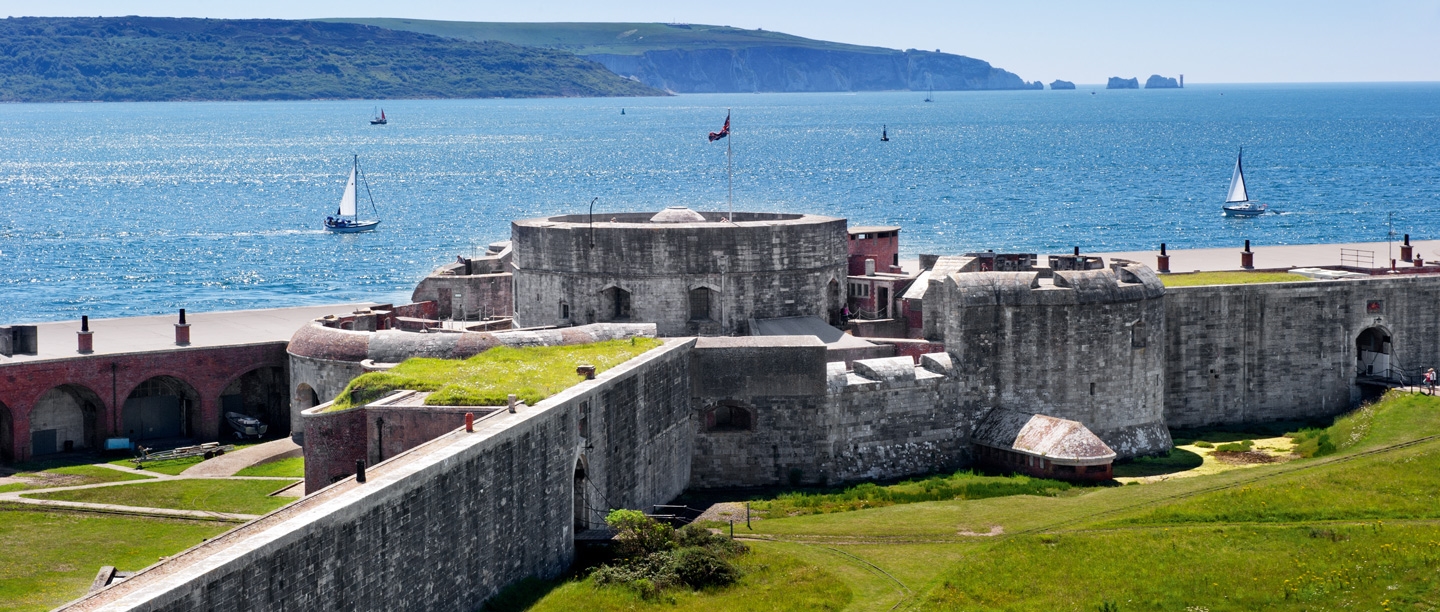Latest update
2024 has seen conservation continue at Hurst Castle. Since the most recent stage of work last year – in which English Heritage commissioned a study of extensive geotechnical investigations around the castle – the charity has maintained the structural movement monitoring system within the east and west wings which currently show stability with movement within tolerance, and has reinforced the timber groynes to the foreshore of the west wing.
Hurst Castle will re-open to the public in March, and by July the castle will also enjoy brand new interpretation around the site, providing a thorough explanation of the castle’s rich history, from the Tudor period to its involvement in the Second World War.
On site, visitors may also spot conservation in action as attention is turned towards maintaining the Coal Store, Canteen Bar and Tap areas of the castle. Unfortunately, during a recent survey structural cracks in the walls on the front of the Canteen building were found, which means it is necessary to close the area while alterations to the roof are considered and the brickwork is conserved. The situation will continue to be monitored.
Elsewhere on site, there will be conservation to the Keep stairway. Added during the late 1880s, when the internal stair between the ground and first floor of the keep was removed, it is a cantilever stair built using limestone blocks. At some point in its history timber supports were also added underneath, but the stonework is showing signs of wear and needs new support, while the harsh coastal setting has also caused the wrought iron balustrades to corrode. English Heritage will be adding a temporary support to keep the stair safe while the limestone treads are conserved and the balustrade is repaired.
Whilst English Heritage is pleased to be able to proceed with its conservation efforts, it must be stressed that there can be no quick fix to the complex issues facing the castle, from sea level rise to climate change. However, these conservation works and investigations will prove invaluable for future protection of the historic structure.
View our statement
Protecting Hurst Castle
Hurst Castle has been in the care of English Heritage and its predecessor the Ministry of Works since 1956, and during that time we have made a number of investments to protecting the castle and its sea defences.
In 2019, we undertook an extensive programme of works totalling £750,000 to stabilise the foundations of the west wing of the castle and to reinforce its sea defences. The charity underpinned the west wing’s foundations, replaced broken groynes and barriers, and replenished the beach with 7,500 tonnes of shingle.
Two years earlier, in 2017, English Heritage invested £1m in a major project to repair and conserve the castle’s roof.
Read about our 2017 projectHow the castle has changed throughout history
The central part of Hurst Castle was built between 1541 and 1544 by Henry VIII as part of a chain of artillery fortresses protecting key ports and landing places around southern England. The castle guarded the Needles Passage leading to the Solent, the port of Southampton and the growing naval base at Portsmouth. Hurst was also occasionally used as a prison – most famously when Charles I was held captive here in 1648.
The castle was greatly modernised in the 19th century, when it formed a key fortress protecting one of the world's most heavily defended areas. Unusually for a Tudor castle, it remained in military use until 1956, playing an active role through both world wars. The castle’s position on the spit has long made it vulnerable to the forces of the wind and waves. With changes in longshore drift, rising sea levels and more frequent storms, Hurst Castle is amongst the most challenging heritage sites to our care to protect, and emblematic of the issues posed by climate change to our heritage.
Visit our history pageA changing seascape
The castle is in an extremely vulnerable position. The shingle spit on which it sits formed naturally from loose flint pebbles as they eroded from the cliffs further west and were transported over the centuries as a result of the forces of wind and waves. With changes in longshore drift, rising sea levels and more frequent storms, the integrity of the spit has often been under pressure, and during a storm in 2014 100,000 tonnes of shingle were displaced overnight, reducing its height by 7m.
As a result of the pressures on the spit, Hurst Castle is amongst the most difficult heritage sites to protect in England, and the site is also at risk from climate change. Environment Agency data from nearby tidal gauges is already showing a net mean increase in sea levels, and estimates suggest that levels will rise in the area by 1m – 1.5m in the next 100 years. The area between Hurst Spit and Lymington is the subject of a large scale multi-agency flood and coastal erosion risk management strategy. As such, the coastal castle is emblematic of the huge challenge posed by climate change to our heritage.
Learn more about the Hurst Spit to Lymington project